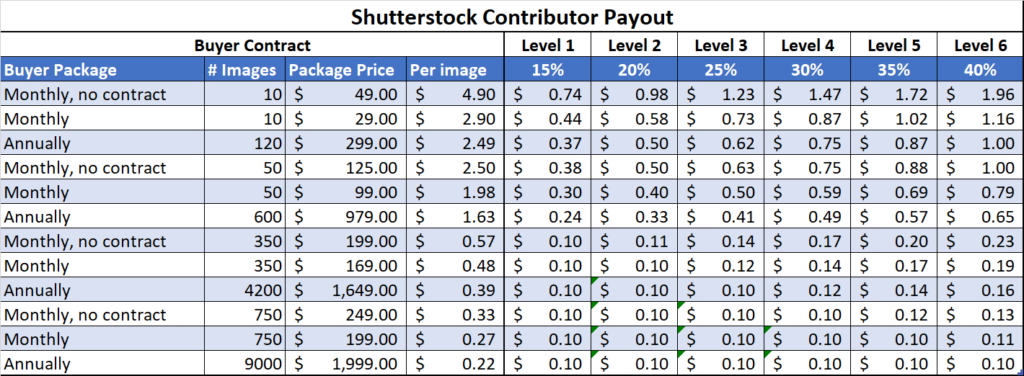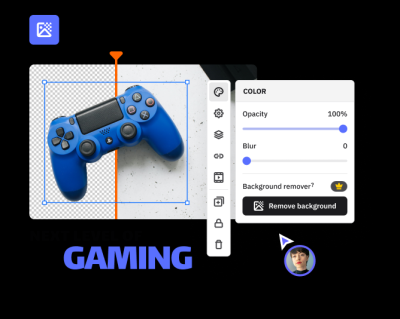Welcome to the world of Shutterstock! If you’re a photographer or graphic designer looking to monetize your images, understanding how your earnings work is key. Shutterstock offers a platform where your photos can reach a global audience, and in return, you earn money every time someone licenses your work. But how exactly does that payment process work? In this post, we’ll break down the essentials so you can have a clear picture of your potential earnings per photo. Whether you’re just starting out or have been contributing for a while, knowing the ins and outs helps you make smarter decisions and maximize your income.
How Shutterstock Calculates Payments for Photographers

So, you’re curious about how Shutterstock figures out how much you earn per photo? Great question! Shutterstock‘s payment system is designed to be transparent, but there are a few key factors that influence your earnings. First, your earnings depend on your royalty rate, which varies based on your contributor level and the type of license purchased.
Here’s a quick overview of how the calculation works:
| Factor | Details |
|---|---|
| License Type | Standard or Enhanced. Enhanced licenses generate higher royalties. |
| Contributor Level | Your level (e.g., Standard, Elite) affects your royalty percentage. The more you sell, the higher your level and earnings potential. |
| Price of the License | The price set by Shutterstock for each license impacts your payout. Higher-priced licenses mean more earnings. |
| Royalty Rate | This is a percentage that varies based on your contributor level and license type. Typically, it ranges from 15% to 40%. |
To put it simply, your earnings per photo are calculated by multiplying the license price by your royalty rate. For example, if a customer purchases a license for $50 and your royalty rate is 20%, you’ll earn $10 for that sale. Keep in mind, Shutterstock takes a small commission for platform fees, but the bulk of the license price goes to you.
Additionally, your contributor level can unlock higher royalty rates and bonus opportunities, which means that as you gain more sales and reputation, your earning potential per photo can increase significantly. It’s a dynamic system designed to reward consistent contributors and those producing high-quality, in-demand images.
Understanding these factors helps you set realistic expectations and strategize your contributions. Focus on creating high-quality images that match market demand, and you’ll see your earnings per photo grow over time!
Factors Influencing Your Income per Photo

Understanding how much you can earn per photo on Shutterstock isn’t always straightforward. Several factors come into play that can either boost your earnings or keep them modest. Let’s dive into some of the key elements that influence your income per photo.
1. Licensing Type
Shutterstock offers two main licensing options: standard and enhanced. Standard licenses are suitable for most uses, but enhanced licenses allow for broader usage, like larger print runs or increased distribution. Typically, earning more per photo comes from licensing your images with an enhanced license, which can significantly increase your payout.
2. Contributor Level and Earnings Tiers
Your contributor level reflects your experience and sales history on Shutterstock. As you sell more images and generate higher earnings, you move up tiers—from Standard Contributor to Elite Contributor. Higher tiers often unlock better royalty rates and higher earning potential per download.
3. Image Quality and Relevance
High-quality, well-composed images that meet current market trends tend to sell more frequently. Shutterstock’s algorithm favors relevant and engaging photos, which means investing time in capturing unique, sharp, and properly edited images can lead to increased downloads and, consequently, higher earnings per photo.
4. Niche and Market Demand
Some niches are more lucrative than others. For example, images related to technology, business, or health can often command higher licensing fees. Keeping an eye on trending topics and market demand can help you focus your efforts on creating images that sell at a higher price point.
5. Geographic and Cultural Relevance
Images that resonate with a global audience or are tailored to specific regions may see higher sales. Understanding the target market and creating culturally relevant content can make your photos more appealing and increase your earnings per photo.
Different Revenue Models on Shutterstock
Shutterstock has a few different ways for contributors to earn money, each with its own benefits and considerations. Knowing these models helps you maximize your income potential.
1. Pay-per-Download Model
This is the most common earning method. You get paid a royalty every time someone downloads your photo. The amount depends on your contributor level, the type of license (standard or enhanced), and your total earnings. The more your photos are downloaded, the more you earn!
| Royalty Tier | Standard License | Enhanced License |
|---|---|---|
| Standard Contributor | $0.25 – $0.38 per download | Higher, depending on the image and license type |
| Elite Contributor | Up to $0.38 per download | Significantly higher, often over $1 per download |
2. Subscription Revenue
Many Shutterstock users purchase subscriptions for bulk downloads. As a contributor, you earn a percentage of the subscription fee based on the number of downloads of your images within the subscription period. This model encourages contributors to produce popular images that get downloaded frequently, even if the per-download payout is lower than a single license.
3. Extended License Sales
When a buyer needs a license for larger-scale commercial use, they might opt for an extended license. These sales often result in higher payouts for the contributor, making it a lucrative avenue if your images are in high demand for commercial purposes.
4. Exclusive Licensing
Although Shutterstock primarily operates on a non-exclusive basis, some contributors choose to license their images exclusively through third-party channels or special arrangements. This can potentially lead to higher earnings per image, but it also limits your distribution on Shutterstock.
By understanding these revenue models and the factors influencing your earnings, you can strategize better to increase your income per photo on Shutterstock. Focus on creating high-quality, relevant images, stay informed about market trends, and explore various licensing opportunities to maximize your potential!
Tips to Maximize Your Earnings from Each Photo
When it comes to earning more on Shutterstock, every little bit counts. The good news is, there are practical strategies you can implement to boost your earnings per photo and make your portfolio more profitable. Let’s dive into some tips that can help you get the most out of your contributions.
Focus on Quality Over Quantity
First and foremost, high-quality images tend to sell better. Invest time in capturing sharp, well-composed, and properly exposed photos. Use good lighting and pay attention to details—clutter-free backgrounds, proper framing, and interesting subjects can make your photos stand out. Remember, buyers are looking for polished images that meet their needs, and high-quality photos often command higher prices.
Stay Trendy and Relevant
Keep an eye on current trends and popular themes. Photos that reflect current events, seasonal topics, or trending subjects tend to attract more buyers. For example, during the holiday season, festive images are in high demand. By aligning your content with what’s hot right now, you increase your chances of sales and higher earnings per photo.
Optimize Your Keywords and Titles
Good metadata is key to your photos being discovered. Use descriptive, accurate titles and tags that match what buyers are searching for. Think about the keywords a buyer might use and include relevant synonyms. The better your photos are tagged, the higher the likelihood they’ll appear in search results, leading to more sales and higher earnings.
Offer Variety in Your Portfolio
While focusing on a niche can be beneficial, offering a diverse range of images increases your chances of sales across different categories. Try to include images with different perspectives, compositions, and themes. This not only broadens your appeal but also gives you more opportunities to earn per photo.
Regularly Upload New Content
Consistent uploads keep your portfolio fresh and active. Shutterstock’s algorithms tend to favor contributors who regularly add new images, which can lead to higher visibility and more sales. Think of your portfolio as a store—keeping it stocked encourages repeat visitors and new buyers alike.
Engage with the Shutterstock Community
Participate in forums or social media groups for Shutterstock contributors. Sharing tips, asking for feedback, and staying informed about platform updates can help you refine your approach. Sometimes, fellow contributors share insights about what’s selling well, giving you ideas to improve your earnings.
Remember, maximizing your earnings is a combination of creating high-quality content, smart marketing, and staying engaged. Implement these tips consistently, and you’ll see your earnings per photo grow over time!
Common Questions About Shutterstock Contributor Payments
If you’re new to contributing or even if you’ve been at it for a while, questions about how payments work can come up. Let’s clear up some of the most common questions to help you understand what to expect and how to manage your earnings on Shutterstock.
How and When Do I Get Paid?
Shutterstock pays contributors via PayPal or Skrill, depending on your location. Payments are made monthly, typically around the 15th of each month, for earnings accumulated in the previous month. To receive payments, you need to reach the minimum payout threshold, which is usually $35. Once you hit this amount, your earnings are processed automatically.
What Are the Different Royalties and How Are They Calculated?
Shutterstock offers different licensing options—Standard and Enhanced licenses—and the royalties you earn depend on your contributor level and the type of license sold. Generally, you’ll earn a percentage of the sale price, with royalty rates increasing as you become a higher-level contributor. The platform provides a detailed breakdown in your dashboard, showing your earnings per download.
Are There Any Fees or Deductions?
There are no hidden fees deducted from your earnings. However, if you choose to withdraw your earnings via PayPal or Skrill, there may be transaction fees associated with those payment providers, depending on their policies. Always review the fee structure of your chosen payout method to understand any costs involved.
What Happens If I Reach the Payout Threshold but Don’t Receive Payment?
If you’ve reached the minimum payout threshold but haven’t received your payment by the expected date, double-check your payment details in your account settings. Sometimes, issues with your payout method or account restrictions can delay payments. If everything looks correct but you still haven’t received your funds, contact Shutterstock support for assistance.
Can I View My Earnings and Reports?
Yes! Shutterstock provides a comprehensive dashboard where you can view real-time earnings, download sales reports, and track your performance. Regularly reviewing these reports helps you understand which images are performing well and guides your future contributions.
Is My Earnings Taxable?
Tax obligations depend on your country of residence. In many cases, earnings from Shutterstock are considered taxable income. It’s a good idea to consult a tax professional to understand your responsibilities and ensure you’re compliant with local laws.
Understanding your payments and how they work is crucial to making the most of your contributor journey on Shutterstock. Stay informed, keep track of your earnings, and don’t hesitate to reach out to support if you have any concerns. Happy shooting and earning!
Conclusion and Next Steps for Shutterstock Contributors
Understanding your earnings per photo on Shutterstock is a crucial step toward optimizing your contributions and maximizing your income. By analyzing your performance metrics, such as download rates, licensing types, and geographic demand, you can identify which images resonate most with buyers and tailor your future uploads accordingly. Remember, consistently uploading high-quality, relevant, and unique images can significantly boost your earnings over time.
Next steps for Shutterstock contributors include:
- Review Your Analytics: Use the Contributor Dashboard to monitor your earnings, popular images, and download trends.
- Optimize Your Portfolio: Regularly update your portfolio with fresh content that aligns with current market demands.
- Experiment with Keywords: Use precise and relevant keywords to improve discoverability.
- Engage with the Community: Join forums and webinars to learn from other successful contributors.
- Stay Informed: Keep up with Shutterstock’s policies, licensing options, and emerging trends to stay competitive.
By taking these proactive steps, you can better understand your earnings per photo and develop strategies to increase your overall income. Success on Shutterstock is a combination of quality content, smart marketing, and ongoing learning—embrace these principles to grow your photography business effectively.


